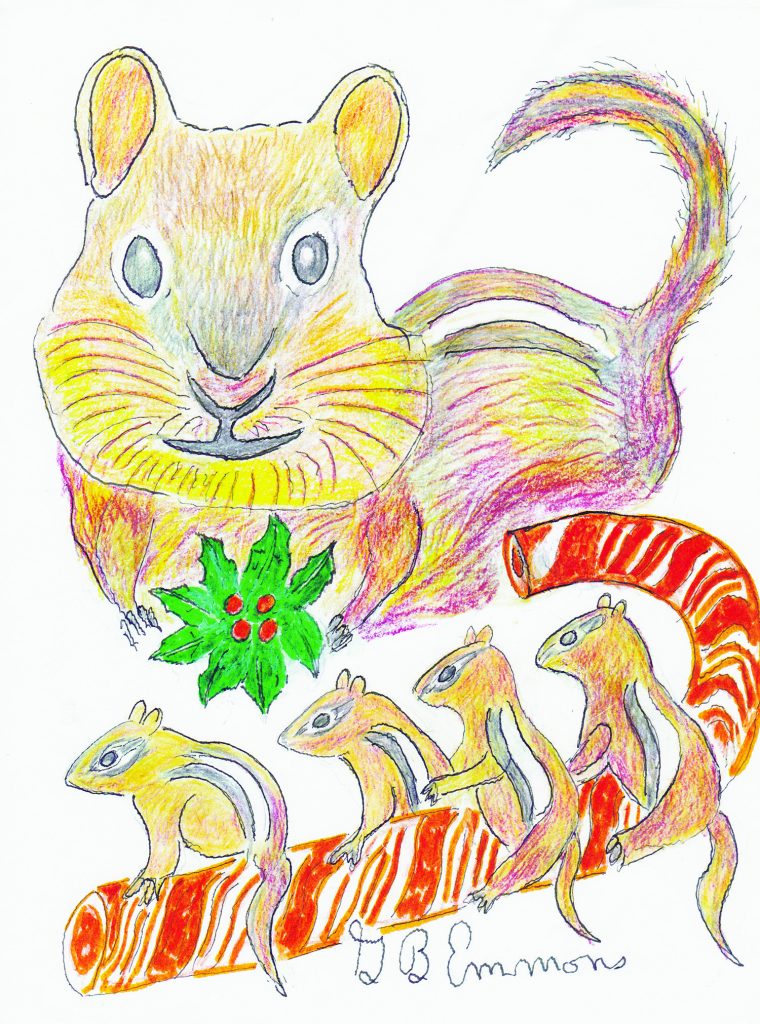The eastern chipmunk, or Tamias striatus, is classified as a striped ground squirrel that gladly shares its habitat with human beings. It comes out daily from a tunnel to an earthly burrow to show its friendly face about mid-morning and then again mid-afternoon.
Its appearance seems to entertain us with a cute scurrilous scampering performance that lives up to its reputation as a cartoon character, particularly for children.
The name ‘chipmunk’ is thought to originate from the Ottawa Native Americans who called it “chit-a–munk” for its pose with puffed out cheeks filled with a mouthful of nuts. It could also have derived from the very vocal chipmunk’s chattering, “chip-chip!”
In the year 1830, James Audubon painted it in a cheeky pouch-filled smiling appearance, as I have also illustrated.
Its habit of spunky scampering through a deciduous forest has a truly miraculous and beneficial purpose of replenishing its own habitat. It often jumps upon a fallen log or tree trunk as a raised pathway and elevated highway for precautionary visibility of its surroundings. If conditions are right, chipmunks usually pick up on their feet single-celled agents of sporophytes, such as moss, mushrooms, bacteria, and algae, and disperse them as start-up mosses wherever they land. And when a Chipmunk climbs around in a spiral up a tree, it leaves in its path a planted corkscrew pattern from top to bottom.
Chipmunks are polygamous, as one male will mate with multiple females during the two breeding seasons a year, spring and then fall. Each litter has from two to five young, and those born in spring, like rabbits, reproduce the following autumn.
The newborn only weighs about three grams and is blind without any fur. A lifespan can range from three to 10 years, and their numbers don’t appear to be threatened; however, populations in forests appear to suffer from fragmentation of their natural range, and so suffer from habitat modification.
In 1958, Alvin and the Chipmunks became entertainment celebrities with a performance group of three animated anthropomorphic personalities, starring Alvin as a mischievous but humorous troublemaker. Written by David Seville, it soon became a best-selling record, and then later a nationally distributed cartoon movie production for children. It soon ranked with other Christmas songs such as Rudolph the Red-Nosed Reindeer, and the Twelve Days of Christmas. The Chipmunk’s harmonics began with the following rhyming Christmas Eve lyrics of a worried child: “Christmas, Christmas time is near – Time for toys and time for cheer…”
Eight stanzas ended with the hope of this child that Alvin’s mischief does not cause Christmas to be late: “We can hardly stand the wait – Please, Christmas, don’t be late…”
The chipmunk, now more easily seen in the leafless trees and contrasted against the white snow on falling stone walls, shares the limelight with the other Christmas critters, such as reindeer, house mice, and, of course, partridges in pear trees.
By George B. Emmons
